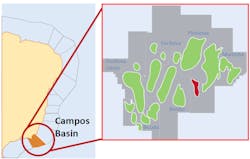Offshore staff
RIO DE JANEIRO – Petrobras will stage a new round of final offers for the sale of the producing Enchova and Pampo field clusters in the Campos basin offshore Brazil.
The company will look to clarify certain rules to ensure transparency and competitiveness in the divestment process.
Enchova, in 1976, was one of the company’s earliest discoveries in the basin. Production started in August 1977.
The Enchova field cluster is in shallow water and up to 90 km (56 mi) from the coast, with reservoir depths of 1,800-2,600 m (5,905-8,530 ft).
Two years ago, when the company originally put the fields up for sale, Enchova was producing from 32 wells and one fixed and four floating platforms.
Oil and gas are exported through pipelines to the onshore Cabiúnas processing complex.
The current license is set to expire in 2025. Petrobras’ original promotion highlighted the potential for multiple increased recovery initiatives including infill drilling, well reconnection and recompletion and water flooding.
The Pampo fields, which produced first oil in the early 1980s, are in shallow water, up to 80 km (49.7 mi) from the coast with reservoir depths of 950-2,950 m (3,117-9,678 ft).
Two years ago, they were producing oil and gas from 27 wells and one fixed and one floating platform. Production heads through pipelines to the PCE-1 platform at the Enchova field and from there to Cabiúnas.
Here too the license is set to expire in 2025. Water injection into the Siri reservoir could help boost production from the Badejo field, and there could be further upside via additional drilling and reconnection at the Pampo, Linguado and Trilha fields.
06/26/2019



